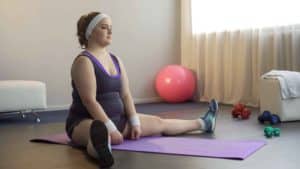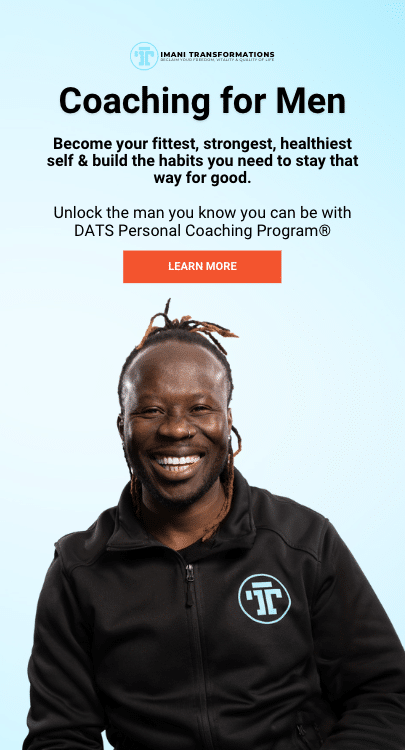You probably think you know how to exercise for weight loss.
But if you’re over 40, chances are you’re taking the wrong approach.
But don’t worry, because we’re about to share with you all you need to know about exercising when you’re over 40.
Move it or lose it
The first thing to understand is that it’s important to move regularly. Losing movement and mobility as you age is easy, but it’s very hard to reclaim.
Studies have shown that regular activity helps you maintain your overall mobility as you age. One study showed that moderate activity helped aging adults maintain their ability to walk at a rate 20% higher than those who were sedentary. The same study showed that consistent exercise resulted in a 28% reduction in people losing their mobility.
Low-intensity Activity (LIA) should be a regular part of your week as it helps keep your body moving and it helps reduce stress, something that can interfere with weight loss. LIA can include walking, cycling, swimming, gardening, or any other activity that keeps you moving without the intense focus of cardio or resistance training. The most common form of LIA is walking.
However, there’s no need to go overboard and join the 10,000 steps a day bandwagon. Just aim to move each day. You can read more about this in our blog Why a 10,000 steps a day challenge is bullshit and what to do instead.
Act your age
While you may still feel like a teenager on the inside, it’s important to remember that you no longer have a body of a teenager! What we mean by that is that you’re not likely to be able to do the same things as you did when you were a teenager. Energy levels are different (particularly if you’re working, running your own business, or raising kids), changing hormones can also interfere with energy levels and mood, and it will take you longer to recover from your sessions.
You’re also likely to experience niggles, twinges or even wear and tear on your body (i.e. joint, muscle or ligament pain), as a result of previous injury or degenerative conditions such as arthritis. Plus, if you have a sedentary job, you’re likely to be less flexible and have less mobility than you did when you were younger.
Failing to take the above into account will increase the risk of you sustaining an injury or burning out, which could see you sidelined for a significant amount of time.
Don’t ignore niggles or pain
If you have a niggle or a pain in a particular muscle group, don’t ignore it! Most of the time this a signal that an opposing muscle group is either not activating or weak. Other reasons you might experience pain include poor form, overtraining leading to an over-use of a particular muscle, or not eating and recovering well enough.
Don’t push through the pain. Pushing through when you experience any level of pain can lead to an injury that will take longer to heal. Visit an appropriate health professional to get your pain assessed and discuss with your trainer to ensure the exercise you’re doing won’t exacerbate your problem.
Remember less is more
Despite what the diet and fitness industries will tell you, you don’t need to spend hours and hours each week exercising. The truth is that exercise is just 3% of the equation when it comes to weight loss. The remaining 97% comes down to your habits and mindset. We explain this in more detail in our blog The 97/3 weight loss strategy.
When it comes to exercise, you shouldn’t need to spend any more than 5 hours a week exercising if you’re doing the right kind of exercise. What’s the right kind of exercise? Glad you asked.
Make resistance training your focus
The biggest influence on our metabolism is our muscle mass. Around 66% of our metabolism is influenced by our muscle mass which means the higher the muscle mass, the faster our metabolism will be and the easier it is to lose weight and keep it off.
For this reason, a structured Focused Intense Resistance Exercise (FIRE) program should be part of everyone’s workout, but especially if you’re over 40. This is because as we get older, we lose muscle mass which causes our metabolism to slow down. Over their lifetime, the average adult will lose 9kg of muscle mass, and replace it with 16kg of fat!
Unfortunately, the rate at which we lose muscle mass accelerates with age. Without strength training, someone who is 40 years of age will have lost 50% of the strength they had in their 20s. By the age of 60, the decline in strength will be as high as 70%!
This decline in muscle mass, and slowing down of the metabolism explains why many people gain weight ‘for no reason’, or find it increasingly difficult to lose weight as they get older.
While it’s also important to do a small amount of cardio exercise in your week, a weight training program should be the foundation of your exercise program. To see any physical changes, it should involve progressive overload which means a gradual increase in weight in order to achieve your goal. This gradual increase of stress placed on the body means you’ll build more muscle — which will fire up your metabolism.
You can read more about the importance of muscle in our blog “I don’t want to get bulky”: 8 reasons why muscle is your friend.
Get the biggest bang for your buck
When exercising over 40, it’s important to focus on the exercises that give you the biggest bang for your buck — compound exercises. Compound exercises are those that require you to use multiple joints and multiple muscle groups. Examples of compound exercises are squats and deadlifts. While they might target a specific muscle region, they also engage most of the entire body as well. In the case of deadlifts, you need to use your quads, hamstrings, glutes, triceps, shoulders, core, lats muscle etc.
Compound exercises are an efficient use of your time as you’ll work more muscles and build more strength in shorter time. They can also help you burn more calories, improve intramuscular coordination (the interaction between your nervous system and muscle), elevate your heart rate, improve flexibility and strength, and gain more muscle.
Warm-up properly
Warming up before your session is crucial. Warming up prepares your mind and your body for your session. When you warm up properly, your muscles are ready to go, and you reduce the chance of injury. When your mind is focused, you’ll get more out of your workout. Warm your body up with dynamic stretches, use a foam roller, massage balls, and roll out any tight spots.
When lifting weights, avoid going straight into lifting your working set. You should perform a few warm-up sets to get your mind and body ready. At Imani Tribe Transformations, our warm up for our FIRE sessions is:
- 12 reps at 20% of your working weight
- 10 reps at 40% of your working weight
- 6 reps at 60% of your working weight
- 3 reps at 80% of your working weight
- 1 rep at your working weight.
After you have completed this warm-up for your first exercise, perform your working sets. This warm-up is only done for the main compound exercise.
Don’t forget mobility and flexibility
As we age, mobility and flexibility are as important as muscle mass.
Mobility is the range of motion of the joints, while flexibility is the range of motion of your muscles. Working on your mobility and flexibility will help you move better, which will help you train better and get better results. It will also help you be able to do daily tasks more easily and will reduce the risk of injury. Having good mobility and flexibility can also help you avoid aches and pains often attributed to ‘old age’. The truth is many of these issues are related to immobility and inflexibility of your body.
To improve your mobility, ensure that you practice executing your exercises in full range of motion. You can improve your flexibility by adding stretching to your training.
Rest and recover
Sleeping, resting and allowing time for recovery is vital if you want to be consistent with your exercise. Adequate rest means you’ll recover properly from your exercise session, which means you’ll be able to turn up to the next one. Sleep will allow your body to rejuvenate and repair itself, and reduce your stress levels. It will also mean you’re focused and ready to train at each session, and when you’re focused and concentrate on what you’re doing, you’ll get better results and reduce the risk of injury.
It’s also important to avoid training week in, week out without a break. You should factor in structured rest time into your training schedule to optimise your training. This won’t slow your results, nor will you lose strength and fitness, or gain weight. Instead, you’ll allow your body to recover sufficiently, so you come back with more energy, more strength and more focus.
At Imani Tribe Transformations. we understand the importance of rest and recovery which is why our DATSTM Program involves training for 10 weeks, and then have 2 weeks off. The 2 weeks off are classified as ‘active recovery’ — walking, swimming, cycling — designed to reduce stress and help us recover.
Eat for recovery
Don’t fall into the trap of trading exercise for food or limiting your food intake to ensure a larger ‘calorie burn’. Your body needs the proper fuel to do a workout in the first place, and it also needs proper nutrition to allow you to recover from your session. Ensure you eat before and after exercise to prime your body with the right fuel. The right workout meals will not only ensure you get the most out of your session while you’re exercising, but they will help you optimise your results and recovery.
You can read more in our blog What are the best workout meals?
Work smarter to stay consistent
When exercising over 40, it’s important to work smarter, not harder otherwise you won’t be consistent with your training. The best and fastest results don’t happen to those who smash out their workouts, but to those who consistently recover from each session and then back up to train at their next session.
A good workout isn’t the longest, hardest, sweatiest, most exhausting or complex. A good workout is one that maximises muscle tension, minimises joint pressure, and is sustainable enough to for you to be consistent with it so you can get closer to your goals.
If you’re looking for a personal trainer in the outer Eastern Suburbs of Melbourne to help you lose weight and keep it off for good, look no further. Our face-to-face DATSTM program includes a personalised, structured exercise training program combining FIRE (Focused Intense Resistance Exercise) and ICE (Intense Cardio Exercise) group training programs, suitable for anyone over (and under) 40.
Just click below to get started.


















